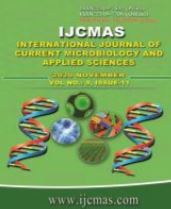


 National Academy of Agricultural Sciences (NAAS)
National Academy of Agricultural Sciences (NAAS)

|
PRINT ISSN : 2319-7692
Online ISSN : 2319-7706 Issues : 12 per year Publisher : Excellent Publishers Email : editorijcmas@gmail.com / submit@ijcmas.com Editor-in-chief: Dr.M.Prakash Index Copernicus ICV 2018: 95.39 NAAS RATING 2020: 5.38 |
Enrofloxacin, an antimicrobial fluoroquinolone is most commonly used against majority of gram negative bacterial and mycoplasma infections in majority of livestock. Indiscriminate usage of enrofloxacin in clinical practice leads to resistance development to this quinolne drug. Among the various pathways of resistance, efflux pump mediated drug resistance is one of the important pathways identified in the recent past. Phytochemicals namely, theobromine, glycyrrhetenic acid and glycyrrhizic acid and capsaicin were identified as efflux pump inhibitors. Phytochemicals which possess efflux pump inhibitory activity if combined with classical antimicrobial agents reduces the development of resistance and also improves their therapeutic efficacy. Interaction between enrofloxacin, and capsaicin, theobromine, glycyrrhetenic acid and glycyrrhizic acid were studied by determining MIC and MBC against E.coli, S.aureus, K.pneumoniae and P.aureginosae following CLSI guidelines. There is a significant decrease in MIC and MBC values of enrofloxacin in the presence of phytochemicals. In conclusion, Synergisitic interaction of efflux protein inhibitory phytochemicals capsaicin, theobromine, glycyrrhetenic acid and glycyrrhizic acid with enrofloxacin was noticed in minimum inhibitory concentration (MIC) and minimum bactericidal concentration.
 |
 |
 |
 |
 |